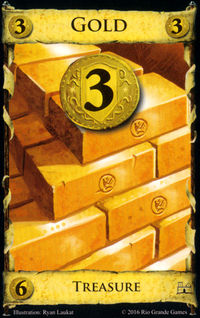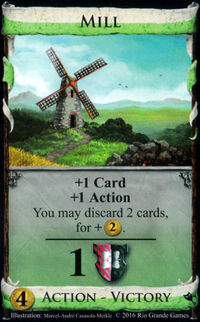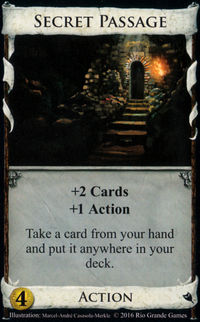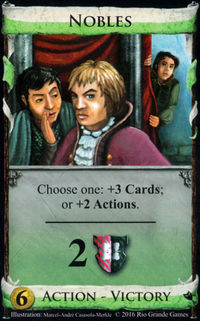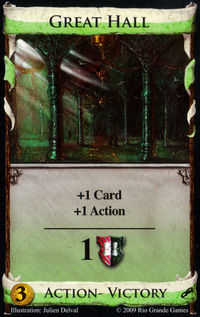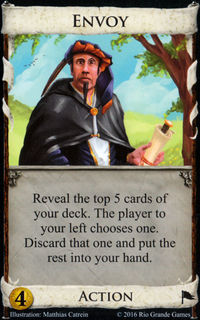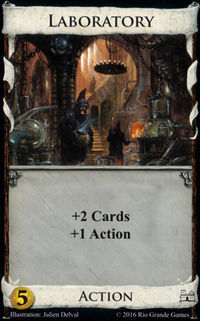Intrigue
| Intrigue | |
|---|---|
 | |
 | |
| Info | |
| Type | Standalone (1st) / Expansion (2nd) |
| Icon |
|
| Cards | 500 (1st) / 300 (2nd) |
|
258 (1st) / 268 (2nd) (25/26 sets) | |
|
208 (1st only) | |
|
25 (1st) / 26 (2nd) | |
Blank Card(s) |
8 (1st) / 6 (2nd) |
Other Card(s) |
1 Trash pile card (1st only) |
| Theme(s) |
|
| Release | July 2009 (1st) / Fall 2016 (2nd) |
| Cover artist | Matthias Catrein (1st) / Joshua Stewart (2nd) / Julien Delval (2nd reprint) |
| Official Rulebook | |
Intrigue is the first expansion to Dominion designed by Donald X. Vaccarino, released in 2009 by publisher Rio Grande Games. The box originally contained 25 sets of Kingdom cards. The first edition contained Basic Supply cards to support up to 4 players, or up to 6 players when combined with those from base Dominion.
The second edition of Intrigue was released in Fall 2016, updating wording and formatting on cards, removing the basic cards, and replacing 6 first-edition Kingdom cards with 7 new ones. The new cards are also available in an update pack provided to allow existing Intrigue sets to be updated to the second-edition form.
The second edition of Intrigue is also included in a newer English-language Big Box version.
[edit] Contents
[edit] Basic Supply cards
These are only available in the first edition; the second edition is only an expansion, so no Basic Supply Cards are included.
[edit] Kingdom cards, second edition
Cards with an asterisk (*) were added in the second edition.
- : Courtyard, Lurker*, Pawn
- : Masquerade, Shanty Town, Steward, Swindler, Wishing Well
- : Baron, Bridge, Conspirator, Diplomat*, Ironworks, Mill*, Mining Village, Secret Passage*
- : Courtier*, Duke, Minion, Patrol*, Replace*, Torturer, Trading Post, Upgrade
- : Farm*, Nobles
[edit] Removed first-edition Kingdom cards
These cards were included in the first edition, and removed from the second edition. Harem was initially included in the second edition, but later replaced with Farm without any new edition.
- : Secret Chamber
- : Great Hall
- : Coppersmith, Scout
- : Saboteur, Tribute
- : Harem
[edit] Additional rules
-
Intrigue has cards that give players a choice between two or more options. A player given a choice picks any choice, even if unable to do the instruction, then does as much of it as they can.
For example, Sylvia plays Steward with one card left in her hand. She can pick the "trash 2 cards from your hand" option despite only having one card in hand. If she picks that option, she trashes the one card in her hand. Sometimes one of the options of a card with a choice is to make +. To track the , players can push the card up slightly from the line of played cards.
-
Intrigue has three Victory cards that have another type as well: Harem, Mill, and Nobles. These cards are both types for all purposes.
For example, since Nobles is an Action card, it can be played in the Action phase, can be trashed from the Supply with Lurker, and so on; since it is a Victory card, it is worth when scoring, is put into a player's hand due to Patrol, and so on.
when scoring, is put into a player's hand due to Patrol, and so on.
[edit] Flavor text
[edit] Mechanics
[edit] Cards gallery
[edit] Kingdom cards
[edit] Removed cards
[edit] Impact
Intrigue broadened the range of possible card effects beyond what was available in the base set in two major ways: it introduced cards that offer a choice between multiple distinct effects, as well as Victory cards with multiple types and functional effects beyond scoring points. Each of these functions would join the arsenal of basic Dominion card-design elements and go on to be reused by Donald X. Vaccarino in multiple future expansions. They nevertheless have held up as the distinctive theme of Intrigue, which contains more Victory kingdom cards than any other expansion, and more cards that offer an explicit choice between distinct effects than any other expansion except Allies, which revisits choices as one of its own themes.
Intrigue also increased the strategic and tactical depth of Dominion beyond what the base set offered by introducing more cards that benefit from advanced play: for example, Wishing Well rewards careful deck-tracking in a way no card in the base set does; Swindler requires paying close attention to an opponent's strategy to know what cards will disrupt it; and Coppersmith and Conspirator require decks specifically tailored to their strengths to be useful.
The first-edition of Intrigue developed a somewhat unfounded reputation as a highly attack-heavy expansion: in actuality, Intrigue contained fewer Attack cards than the base set and fewer than the next expansion, Seaside. This reputation arose in part from the fact that the Attack cards Intrigue did have had a reputation as particularly annoying attacks to get hit by (even the relatively weak Saboteur, which is unpleasant out of proportion to how effective it is), and in part because it had some non-Attack cards (Masquerade and Tribute) that affect players in ways that occasionally make them feel like they're being attacked. The second edition has removed both Saboteur and Tribute, and has a slightly modified Masquerade which has been revised to avoid the most punishing use from the first edition version.
[edit] Theme
Game designer Donald X. offered some insight into some themes of the set here, with how the Kingdom cards fit into that theme:
- 10 Choices: Pawn, Masquerade, Steward, Swindler, Wishing Well, Baron, Mining Village, Minion, Torturer, Nobles
- 7 Also choices, but less unique: Courtyard, Secret Chamber (Passage), Ironworks, Scout (Patrol), Saboteur (Replace), Trading Post, Upgrade
- 4 Victory cards: Great Hall (Mill), Duke, Harem, Nobles
- 5 Cards interacting with Victory cards: Baron, Ironworks, Scout (Patrol), Duke, Tribute (Replace)
- 4 Off-theme: Shanty Town, Bridge, Conspirator, Coppersmith
[edit] Alternate versions
First Polish version (by Bard)
Second Polish version (by GFP - note: this is still Intrigue First Edition)
[edit] Trivia
When Intrigue was revamped for the second edition, it received new box art. However, it was discovered that the artist had used a photograph of Renaissance Fair players without their consent as a reference for the artwork, and it was replaced with art from a different artist when it was reprinted.
[edit] In other languages
- Chinese: 暗潮洶湧 (pron. àncháo xiōngyǒng, lit. surging undercurrent)
- Czech: Intriky
- Dutch: Intrige
- Finnish: Hovin juonet (lit. courtly plots)
- French: L'Intrigue
- German: Die Intrige
- Hungarian: Intrika
- Italian: Intrigo
- Japanese: 陰謀 (pron. inbō, lit. conspiracy)
- Korean: 장막 뒤의 사람들 (pron. jangmag dwiui salamdeul, lit. people behind the curtain)
- Norwegian: Intrigue
- Polish: Intryga
- Russian: Интрига (pron. intriga)
- Spanish: Intriga
[edit] Secret History (1E)
From the start, Intrigue was groomed to be the first expansion. To me that meant making it the most true to the main set. If the first expansion was especially exotic, then when only the main set and that expansion were out, half the game would consist of this exotic stuff. If the second expansion is the first exotic one, then it's down to a third of your cards (if you have the first expansion too) (of course it's even less if not all of the second expansion is exotic). That seems more reasonable. The mechanics in the first expansion are things that to me are just a basic part of the game; later expansions may not have as many victory cards that do things or cards that say "choose one," but they'll have those things when they're wanted. The main set didn't have those things in part to keep it simple for new players and in part because you can only fit so much in 25 cards.
Any card that didn't make the set may still make a later set in a fixed-up form, depending on how many expansions actually come out and stuff. So I don't want to just tell you what all of the outtakes were. Probably I can tell you a bit about them though.
- Two cards went into the main set: Feast and Chancellor. In general you probably can't tell anything from the names of transplanted cards, which may have been changed anyway; but in this case they weren't and you can: feasting and chancellors fit right into this set.
- Envoy left the set and then became a promo. I am kind of embarrassed by it - it left this set because it didn't add enough to the game, and then it became a promo and well that's still an issue, right? It does at least have the merit there of not making people feel as much like they have to have it. But the thing is, we found out we needed the promo the same day it was needed. There was no time to test a new card, and Envoy was one of a small number of cards that had actually had some external playtesting (other than the cards in the set, which I didn't want to give up). And I do like the card; it totally could have made a later expansion, providing some card-drawing for that expansion and a new experience, if not new decks. They can't all be Gardens. It's just sad to have this early on because each card matters more now; with just the main set you only have 25 cards and this one does not carve out much new territory. Anyway I suggested it for the promo and it escaped to promo-land and so much for that. Over time it will matter less that it doesn't add so much.
- There was that broken card that Conspirator replaced. W. Eric Martin is the one who reported a friend of his getting over 50 coins in a turn with this. Well if I make a fixed-up version I will tell you all about it then.
- There was that reaction card that didn't make it. It tied into the one-shot theme and just wasn't useful enough without it.
- There was the attack that Swindler replaced. I tried three different versions of it, all one-shots, and well people don't like one-shots. It was considered for the promo but just hadn't had any fans.
- There was another one-shot attack. There was a one-shot card-drawer that moved to a later set. There was another card that was sometimes a one-shot. There was an exotic one-shot that became a non-one-shot and moved to a later set.
- There was a vanilla card. These are cards that just have some mix of +'s. I think they're worth doing at the rate of like one per expansion or so. They're really uninteresting to hear about but can still fill some important function in the set. There are six in the main set (Village Woodcutter Smithy Festival Laboratory Market) and people do like most of them. But they're not too exciting in expansions. Anyway there was one and it didn't stick around and that's why. The set already had Great Hall and Harem and that was plenty of vanilla. It could still show up later, if I ever need exactly what it offers.
- There was an attack that could steal any type of card, not just treasures. I had a version that I thought was fair, but it slowed the game down way too much. That concept could still come back someday.
- There was a "choose one" card with three weak and complex abilities. Not a crowd-pleaser.
- There was a card in the Gardens family that was worth 1 ![]() per 4 cards in your deck costing up to , other than Curse and Confusion (a Curse-like card that just did nothing). Gardens is a better version of that concept; limiting it to cheap cards doesn't change much, since cheap cards are what you can most readily buy with Gardens. I mean it's different but not interestingly so. And counting Curses is better than not counting them. This card predated Gardens, which was originally designed for a later set.
per 4 cards in your deck costing up to , other than Curse and Confusion (a Curse-like card that just did nothing). Gardens is a better version of that concept; limiting it to cheap cards doesn't change much, since cheap cards are what you can most readily buy with Gardens. I mean it's different but not interestingly so. And counting Curses is better than not counting them. This card predated Gardens, which was originally designed for a later set.
- There were a couple different cards that had "trash the top card of your deck" as a penalty. Talk about crowd-pleasing.
- There was another attack that trashed cards; Saboteur replaced it. Prior to development of the main set, there were a bunch of cards in different expansions that were variations on "trash the top card of each other player's deck." Once it became apparent that that concept was flawed, all of those cards needed reworking, and some just died.
- There were two other cards that let you discard stuff for an effect, both of which could make it somewhere eventually in some form.
- There were two Workshop variants (at different times) that weren't interesting enough. Ironworks has that slot now.
And that's that.[edit] Other cards that could have been removed in 2E
- Harem. It's called Harem. It would have left but it shows a real person.
- Baron. It's not so fun to think the move is to open with it and then draw it with no Estates.
- Trading Post. I don't like how it's good turn one and sucks if you get it later.
- Minion. More hated than Swindler.
- Mining Village. It should trigger e.g. at start of buy phase, both for tracking and to save time considering it. But I couldn't just change that and call it Mining Village.
The last card to go was Coppersmith. Some people miss it. Possibly Baron or Trading Post would have been a better call.
[edit] Recommended sets of 10
[edit] Intrigue only
| Victory Dance [images] | ||||||||||||||
|---|---|---|---|---|---|---|---|---|---|---|---|---|---|---|
| Baron | Courtier | Duke | Harem | Ironworks | ||||||||||

|

|

|

|

| ||||||||||
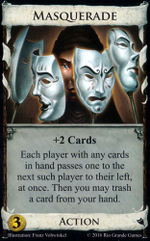
|

|

|

|

| ||||||||||
| Masquerade | Mill | Nobles | Patrol | Replace | ||||||||||
| The Plot Thickens [images] | ||||||||||||||
|---|---|---|---|---|---|---|---|---|---|---|---|---|---|---|
| Conspirator | Ironworks | Lurker | Pawn | Mining Village | ||||||||||

|

|

|

|

| ||||||||||

|

|

|

|

| ||||||||||
| Secret Passage | Steward | Swindler | Torturer | Trading Post | ||||||||||
| Best Wishes [images] | ||||||||||||||
|---|---|---|---|---|---|---|---|---|---|---|---|---|---|---|
| Baron | Conspirator | Courtyard | Diplomat | Duke | ||||||||||

|

|

|

|

| ||||||||||

|

|

|

|

| ||||||||||
| Secret Passage | Shanty Town | Torturer | Upgrade | Wishing Well | ||||||||||
[edit] Intrigue & Dominion
| Underlings [images] | ||||||||||||||
|---|---|---|---|---|---|---|---|---|---|---|---|---|---|---|
| Cellar | Festival | Library | Sentry | Vassal | ||||||||||

|

|

|

|

| ||||||||||

|

|

|

|

| ||||||||||
| Courtier | Diplomat | Minion | Nobles | Pawn | ||||||||||
| Grand Scheme [images] | ||||||||||||||
|---|---|---|---|---|---|---|---|---|---|---|---|---|---|---|
| Artisan | Council Room | Market | Militia | Workshop | ||||||||||

|

|

|

|

| ||||||||||

|

|

|

|

| ||||||||||
| Bridge | Mill | Mining Village | Patrol | Shanty Town | ||||||||||
| Deconstruction [images] | ||||||||||||||
|---|---|---|---|---|---|---|---|---|---|---|---|---|---|---|
| Bandit | Mine | Remodel | Throne Room | Village | ||||||||||

|

|

|

|

| ||||||||||

|

|

|

|

| ||||||||||
| Diplomat | Harem | Lurker | Replace | Swindler | ||||||||||
[edit] Intrigue & Seaside
| A Star to Steer By [images] | ||||||||||||||
|---|---|---|---|---|---|---|---|---|---|---|---|---|---|---|
| Courtier | Diplomat | Secret Passage | Swindler | Wishing Well | ||||||||||

|

|

|

|

| ||||||||||

|

|

|

|
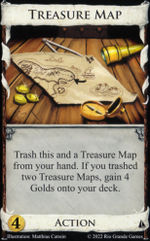
| ||||||||||
| Bazaar | Lookout | Monkey | Tide Pools | Treasure Map | ||||||||||
| Shore Patrol [images] | ||||||||||||||
|---|---|---|---|---|---|---|---|---|---|---|---|---|---|---|
| Patrol | Pawn | Replace | Shanty Town | Trading Post | ||||||||||

|

|

|

|

| ||||||||||

|

|

|

|

| ||||||||||
| Cutpurse | Island | Lighthouse | Sea Chart | Wharf | ||||||||||
[edit] Intrigue & Alchemy
| Servants [images] | ||||||||||||||
|---|---|---|---|---|---|---|---|---|---|---|---|---|---|---|
| Conspirator | Mill | Minion | Pawn | Steward | ||||||||||

|

|

|

|

| ||||||||||

|

|

|

|

| ||||||||||
| Golem | Possession | Scrying Pool | Transmute | Vineyard | ||||||||||
| Landscapes and Additional Cards | ||||||||||||||
| Potion | ||||||||||||||

| ||||||||||||||
| Secret Research [images] | ||||||||||||||
|---|---|---|---|---|---|---|---|---|---|---|---|---|---|---|
| Bridge | Masquerade | Minion | Nobles | Shanty Town | ||||||||||

|

|

|

|

| ||||||||||

|

|

|

|

| ||||||||||
| Torturer | Familiar | Herbalist | Philosopher's Stone | University | ||||||||||
| Landscapes and Additional Cards | ||||||||||||||
| Potion | ||||||||||||||

| ||||||||||||||
| Pools, Tools, and Fools [images] | ||||||||||||||
|---|---|---|---|---|---|---|---|---|---|---|---|---|---|---|
| Baron | Ironworks | Lurker | Nobles | Trading Post | ||||||||||

|

|

|

|

| ||||||||||

|

|

|

|

| ||||||||||
| Wishing Well | Apothecary | Apprentice | Golem | Scrying Pool | ||||||||||
| Landscapes and Additional Cards | ||||||||||||||
| Potion | ||||||||||||||

| ||||||||||||||
[edit] Intrigue & Prosperity
| Paths to Victory [images] | ||||||||||||||
|---|---|---|---|---|---|---|---|---|---|---|---|---|---|---|
| Bishop | Collection | Magnate | Monument | Peddler | ||||||||||
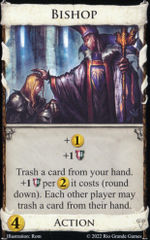
|

|

|

|

| ||||||||||

|

|

|

|

| ||||||||||
| Baron | Harem | Pawn | Shanty Town | Upgrade | ||||||||||
| Landscapes and Additional Cards | ||||||||||||||
| Platinum | Colony | |||||||||||||

|

| |||||||||||||
| Lucky Seven [images] | ||||||||||||||
|---|---|---|---|---|---|---|---|---|---|---|---|---|---|---|
| Bank | Expand | Forge | King's Court | Vault | ||||||||||

|

|

|

|
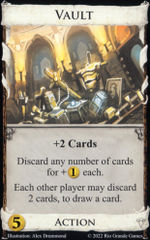
| ||||||||||

|

|

|

|

| ||||||||||
| Bridge | Lurker | Patrol | Swindler | Wishing Well | ||||||||||
| Landscapes and Additional Cards | ||||||||||||||
| Platinum | Colony | |||||||||||||

|

| |||||||||||||
[edit] Intrigue & Cornucopia & Guilds
| The Spice of Life [images] | ||||||||||||||
|---|---|---|---|---|---|---|---|---|---|---|---|---|---|---|
| Fairgrounds | Horn of Plenty | Joust | Remake | Young Witch | ||||||||||

|
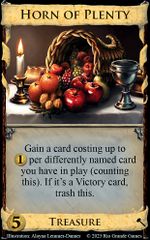
|
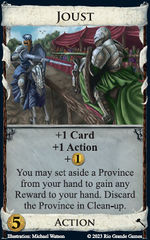
|

|

| ||||||||||

|

|

|

|

| ||||||||||
| Courtier | Courtyard | Diplomat | Mining Village | Replace | ||||||||||
| Landscapes and Additional Cards | ||||||||||||||
| Bane pile: Wishing Well |
||||||||||||||

| ||||||||||||||
| Tricks of the Trade [images] | ||||||||||||||
|---|---|---|---|---|---|---|---|---|---|---|---|---|---|---|
| Butcher | Herald | Journeyman | Stonemason | Soothsayer | ||||||||||

|

|

|

|

| ||||||||||

|

|

|

|

| ||||||||||
| Conspirator | Masquerade | Mill | Nobles | Secret Passage | ||||||||||
[edit] Intrigue & Hinterlands
| Money for Nothing [images] | ||||||||||||||
|---|---|---|---|---|---|---|---|---|---|---|---|---|---|---|
| Replace | Patrol | Pawn | Shanty Town | Torturer | ||||||||||

|

|

|

|

| ||||||||||

|

|

|

|

| ||||||||||
| Cache | Cartographer | Jack of all Trades | Silk Road | Tunnel | ||||||||||
| The Duke's Ball [images] | ||||||||||||||
|---|---|---|---|---|---|---|---|---|---|---|---|---|---|---|
| Conspirator | Duke | Harem | Masquerade | Upgrade | ||||||||||

|

|

|

|

| ||||||||||

|

|

|

|

| ||||||||||
| Guard Dog | Haggler | Inn | Scheme | Trail | ||||||||||
[edit] Intrigue & Dark Ages
| Prophecy [images] | |||||||||||||||||
|---|---|---|---|---|---|---|---|---|---|---|---|---|---|---|---|---|---|
| Armory | Ironmonger | Mystic | Rebuild | Vagrant | |||||||||||||

|

|

|

|

| |||||||||||||

|

|

|

|

| |||||||||||||
| Baron | Conspirator | Nobles | Secret Passage | Wishing Well | |||||||||||||
| Landscapes and Additional Cards | |||||||||||||||||
| Shelters | |||||||||||||||||

| |||||||||||||||||
| Invasion [images] | |||||||||||||||||
|---|---|---|---|---|---|---|---|---|---|---|---|---|---|---|---|---|---|
| Beggar | Marauder | Rogue | Squire | Urchin | |||||||||||||

|

|

|

|

| |||||||||||||

|

|

|

|

| |||||||||||||
| Diplomat | Harem | Swindler | Torturer | Upgrade | |||||||||||||
| Landscapes and Additional Cards | |||||||||||||||||
| Ruins | Shelters | ||||||||||||||||

|

| ||||||||||||||||
[edit] Intrigue & Adventures
| Royalty Factory [images] | |||||||||||||||||
|---|---|---|---|---|---|---|---|---|---|---|---|---|---|---|---|---|---|
| Bridge Troll | Duplicate | Page | Raze | Royal Carriage | |||||||||||||

|

|

|

|

| |||||||||||||

|

|

|

|

| |||||||||||||
| Conspirator | Courtier | Harem | Nobles | Swindler | |||||||||||||
| Landscapes and Additional Cards | |||||||||||||||||
| Pilgrimage | |||||||||||||||||

| |||||||||||||||||
| Masters of Finance [images] | ||||||||||||||||||||
|---|---|---|---|---|---|---|---|---|---|---|---|---|---|---|---|---|---|---|---|---|
| Artificer | Distant Lands | Gear | Transmogrify | Wine Merchant | ||||||||||||||||

|

|

|

|
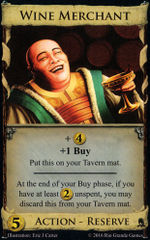
| ||||||||||||||||

|

|

|

|

| ||||||||||||||||
| Bridge | Pawn | Shanty Town | Steward | Upgrade | ||||||||||||||||
| Landscapes and Additional Cards | ||||||||||||||||||||
| Ball | Borrow | |||||||||||||||||||

|

| |||||||||||||||||||
[edit] Intrigue & Empires
| Delicious Torture [images] | ||||||||||||||||||||
|---|---|---|---|---|---|---|---|---|---|---|---|---|---|---|---|---|---|---|---|---|
| Castles | Crown | Enchantress | Sacrifice | Settlers | ||||||||||||||||

|

|

|

|

| ||||||||||||||||

|

|

|

|

| ||||||||||||||||
| Baron | Bridge | Harem | Ironworks | Torturer | ||||||||||||||||
| Landscapes and Additional Cards | ||||||||||||||||||||
| Banquet | Arena | |||||||||||||||||||

|

| |||||||||||||||||||
| Buddy System [images] | ||||||||||||||||||||
|---|---|---|---|---|---|---|---|---|---|---|---|---|---|---|---|---|---|---|---|---|
| Archive | Capital | Catapult | Engineer | Forum | ||||||||||||||||

|

|

|

|

| ||||||||||||||||

|

|

|

|

| ||||||||||||||||
| Masquerade | Mining Village | Nobles | Pawn | Trading Post | ||||||||||||||||
| Landscapes and Additional Cards | ||||||||||||||||||||
| Salt the Earth | Wolf Den | |||||||||||||||||||

|

| |||||||||||||||||||
[edit] Intrigue & Nocturne
| Shadowy Figures [images] | ||||||||||||||
|---|---|---|---|---|---|---|---|---|---|---|---|---|---|---|
| Cobbler | Conclave | Faithful Hound | Shepherd | Tragic Hero | ||||||||||

|
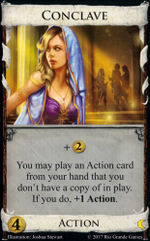
|

|

|

| ||||||||||

|

|

|

|

| ||||||||||
| Bridge | Conspirator | Mill | Nobles | Secret Passage | ||||||||||
| Impending Doom [images] | ||||||||||||||
|---|---|---|---|---|---|---|---|---|---|---|---|---|---|---|
| Leprechaun | Monastery | Necromancer | Tormentor | Werewolf | ||||||||||

|

|

|

|

| ||||||||||

|

|

|

|

| ||||||||||
| Courtier | Lurker | Mining Village | Swindler | Upgrade | ||||||||||
| Landscapes and Additional Cards | ||||||||||||||
| Hexes | ||||||||||||||

| ||||||||||||||
[edit] Intrigue & Renaissance
| Memento Mori [images] | ||||||||||||||||||||
|---|---|---|---|---|---|---|---|---|---|---|---|---|---|---|---|---|---|---|---|---|
| Experiment | Flag Bearer | Patron | Recruiter | Silk Merchant | ||||||||||||||||

|

|

|
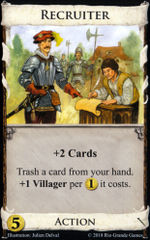
|

| ||||||||||||||||

|

|

|

|

| ||||||||||||||||
| Ironworks | Lurker | Patrol | Swindler | Upgrade | ||||||||||||||||
| Landscapes and Additional Cards | ||||||||||||||||||||
| Citadel | Flag | |||||||||||||||||||

|

| |||||||||||||||||||
| Clockwork Court [images] | ||||||||||||||||||||
|---|---|---|---|---|---|---|---|---|---|---|---|---|---|---|---|---|---|---|---|---|
| Acting Troupe | Inventor | Research | Scepter | Scholar | ||||||||||||||||

|

|

|

|

| ||||||||||||||||

|

|

|

|

| ||||||||||||||||
| Courtier | Mining Village | Nobles | Replace | Steward | ||||||||||||||||
| Landscapes and Additional Cards | ||||||||||||||||||||
| Fleet | Sinister Plot | |||||||||||||||||||

|

| |||||||||||||||||||
[edit] Intrigue & Menagerie
| Dog & Pony Show [images] | ||||||||||||||||||||
|---|---|---|---|---|---|---|---|---|---|---|---|---|---|---|---|---|---|---|---|---|
| Camel Train | Cavalry | Goatherd | Paddock | Sheepdog | ||||||||||||||||

|

|
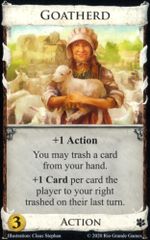
|

|

| ||||||||||||||||

|

|

|

|

| ||||||||||||||||
| Mill | Nobles | Pawn | Torturer | Upgrade | ||||||||||||||||
| Landscapes and Additional Cards | ||||||||||||||||||||
| Commerce | Way of the Horse | |||||||||||||||||||

|

| |||||||||||||||||||
| Explosions [images] | ||||||||||||||||||||
|---|---|---|---|---|---|---|---|---|---|---|---|---|---|---|---|---|---|---|---|---|
| Animal Fair | Bounty Hunter | Coven | Hunting Lodge | Scrap | ||||||||||||||||

|
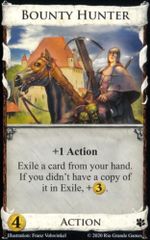
|

|
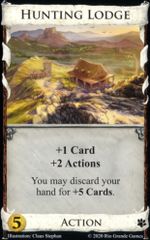
|

| ||||||||||||||||

|

|

|

|

| ||||||||||||||||
| Courtyard | Diplomat | Lurker | Replace | Wishing Well | ||||||||||||||||
| Landscapes and Additional Cards | ||||||||||||||||||||
| Populate | Way of the Squirrel | |||||||||||||||||||

|

| |||||||||||||||||||
[edit] Intrigue & Allies
| Dark Dealings [images] | |||||||||||||||||
|---|---|---|---|---|---|---|---|---|---|---|---|---|---|---|---|---|---|
| Broker | Contract | Courier | Hunter | Townsfolk | |||||||||||||

|
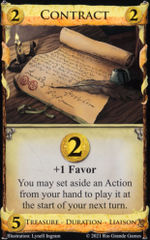
|

|

|

| |||||||||||||

|

|

|

|

| |||||||||||||
| Courtier | Lurker | Nobles | Secret Passage | Steward | |||||||||||||
| Landscapes and Additional Cards | |||||||||||||||||
| Circle of Witches | |||||||||||||||||

| |||||||||||||||||
| Pawns and Underlings [images] | |||||||||||||||||
|---|---|---|---|---|---|---|---|---|---|---|---|---|---|---|---|---|---|
| Innkeeper | Merchant Camp | Swap | Underling | Wizards | |||||||||||||

|

|

|
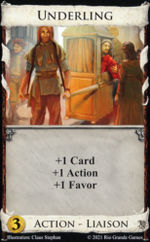
|

| |||||||||||||

|

|

|

|

| |||||||||||||
| Baron | Conspirator | Patrol | Pawn | Replace | |||||||||||||
| Landscapes and Additional Cards | |||||||||||||||||
| Plateau Shepherds | |||||||||||||||||

| |||||||||||||||||
[edit] Intrigue & Plunder
| Breaking Eggs [images] | |||||||||||||||||
|---|---|---|---|---|---|---|---|---|---|---|---|---|---|---|---|---|---|
| Buried Treasure | Jewelled Egg | Mapmaker | Maroon | Quartermaster | |||||||||||||

|

|

|

|

| |||||||||||||

|

|

|

|

| |||||||||||||
| Courtier | Harem | Mining Village | Nobles | Replace | |||||||||||||
| Landscapes and Additional Cards | |||||||||||||||||
| Trait for Maroon Reckless |
|||||||||||||||||

| |||||||||||||||||
| Landlubbers [images] | ||||||||||||||||||||
|---|---|---|---|---|---|---|---|---|---|---|---|---|---|---|---|---|---|---|---|---|
| Cutthroat | Fortune Hunter | Pendant | Pilgrim | Wealthy Village | ||||||||||||||||

|

|

|

|

| ||||||||||||||||

|

|

|

|

| ||||||||||||||||
| Conspirator | Mill | Pawn | Secret Passage | Wishing Well | ||||||||||||||||
| Landscapes and Additional Cards | ||||||||||||||||||||
| Trait for Conspirator Friendly |
Avoid | |||||||||||||||||||

|

| |||||||||||||||||||





